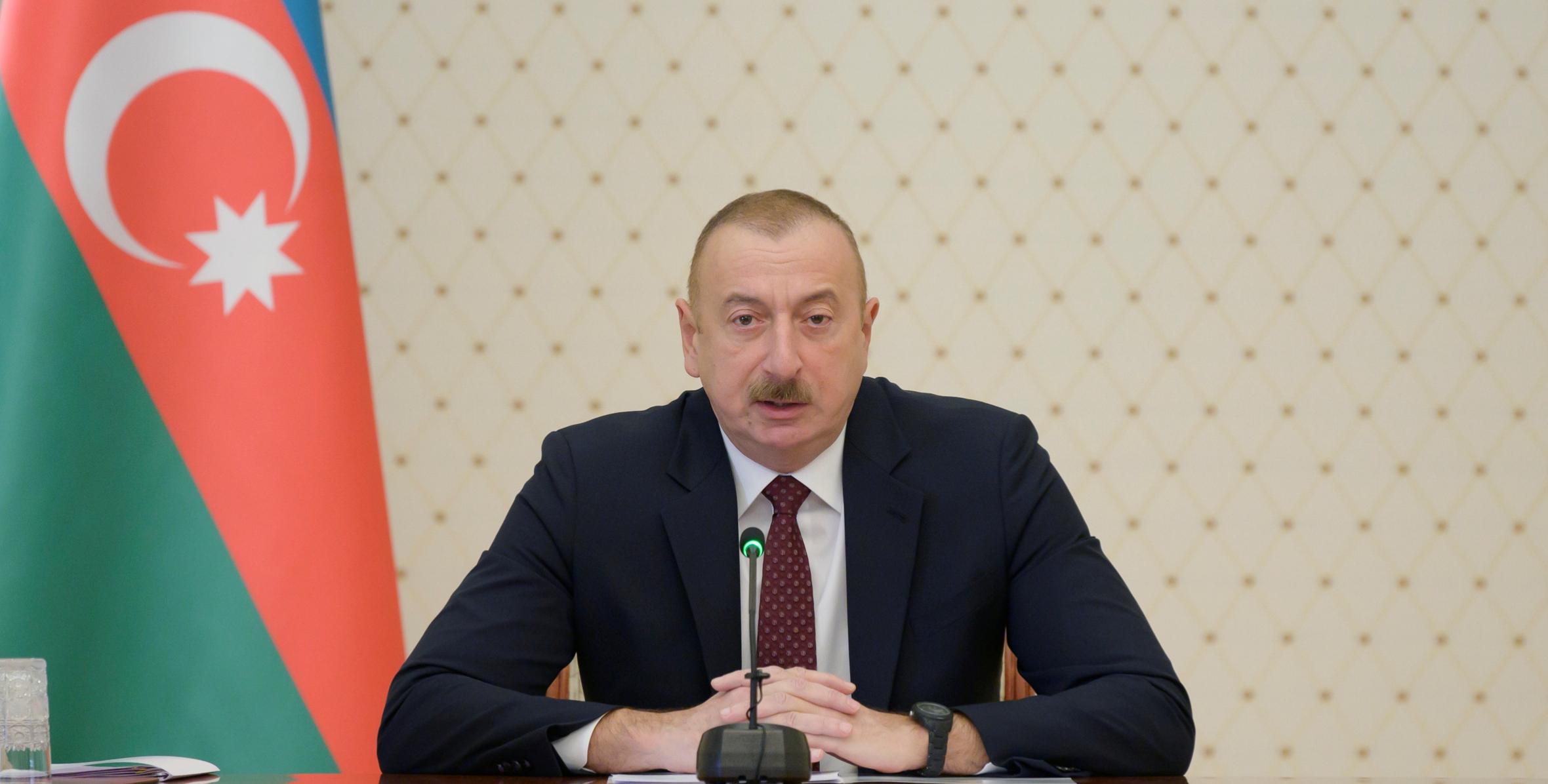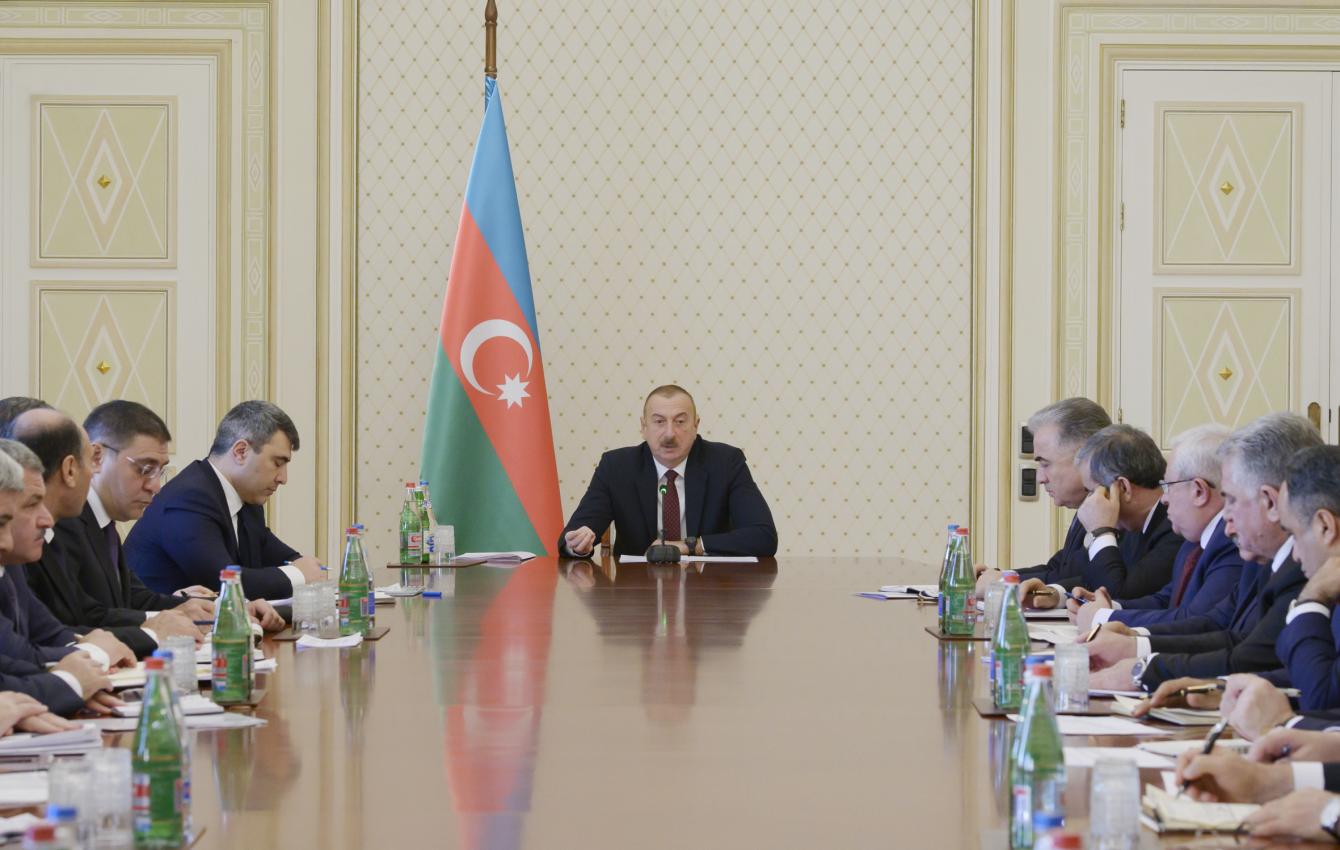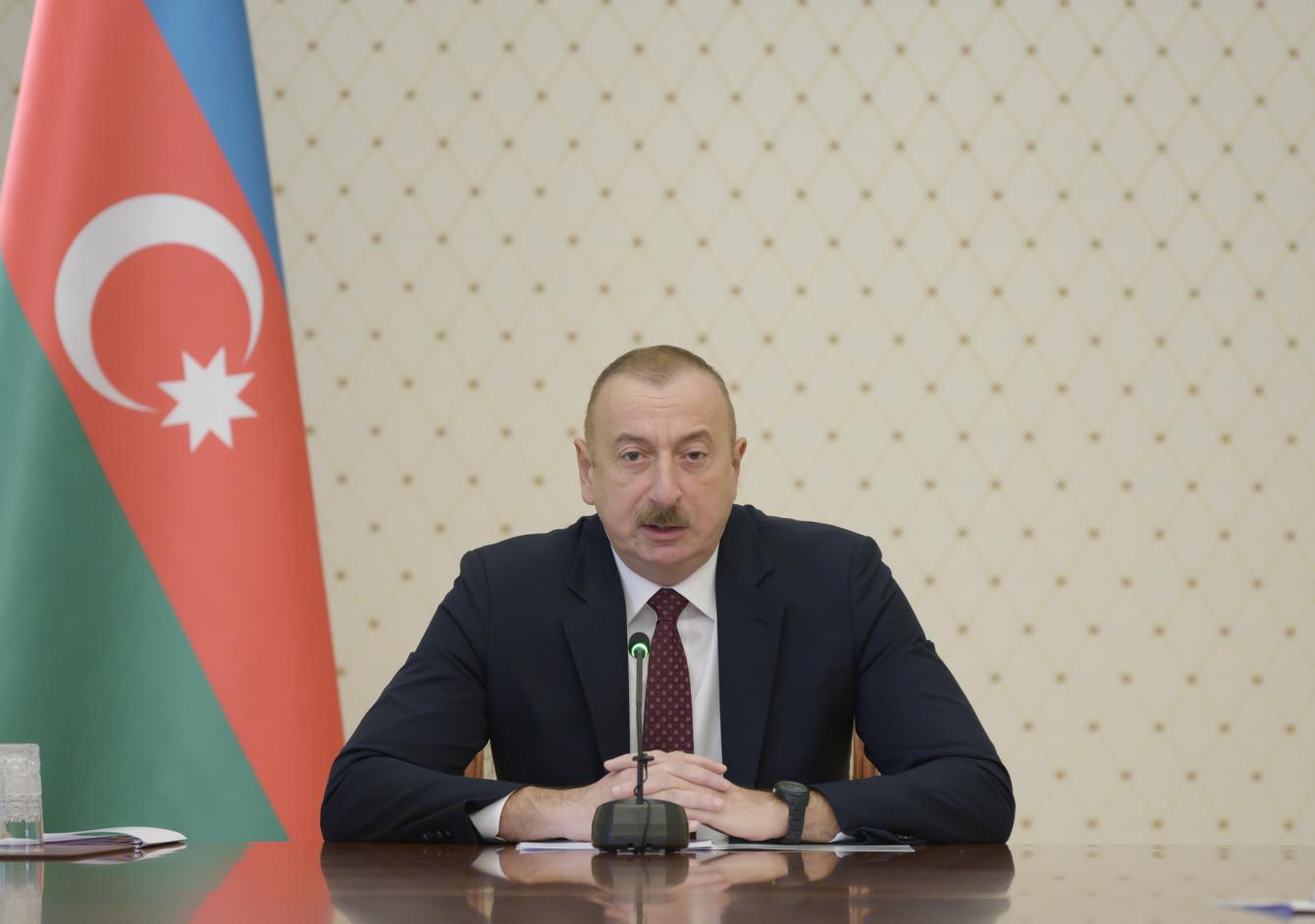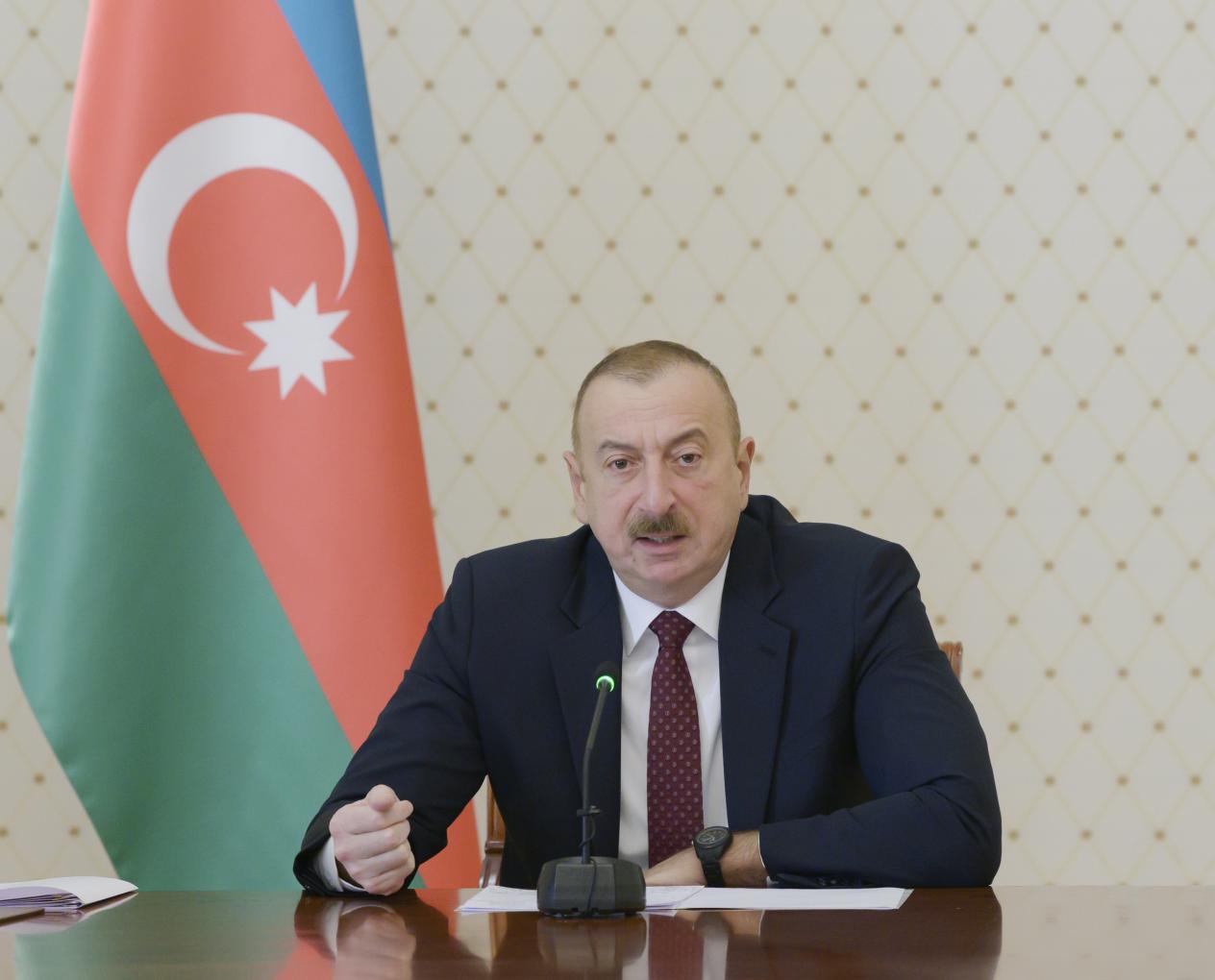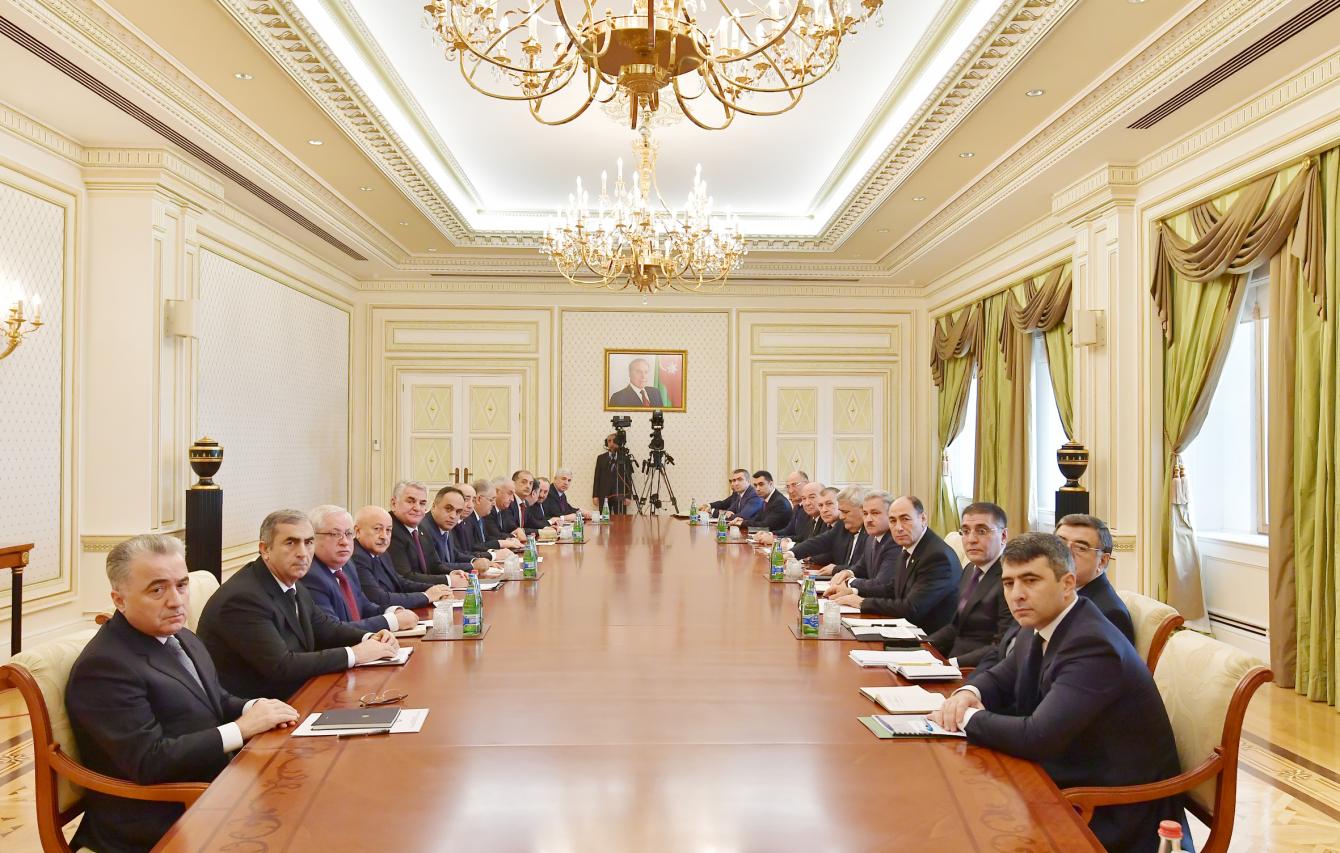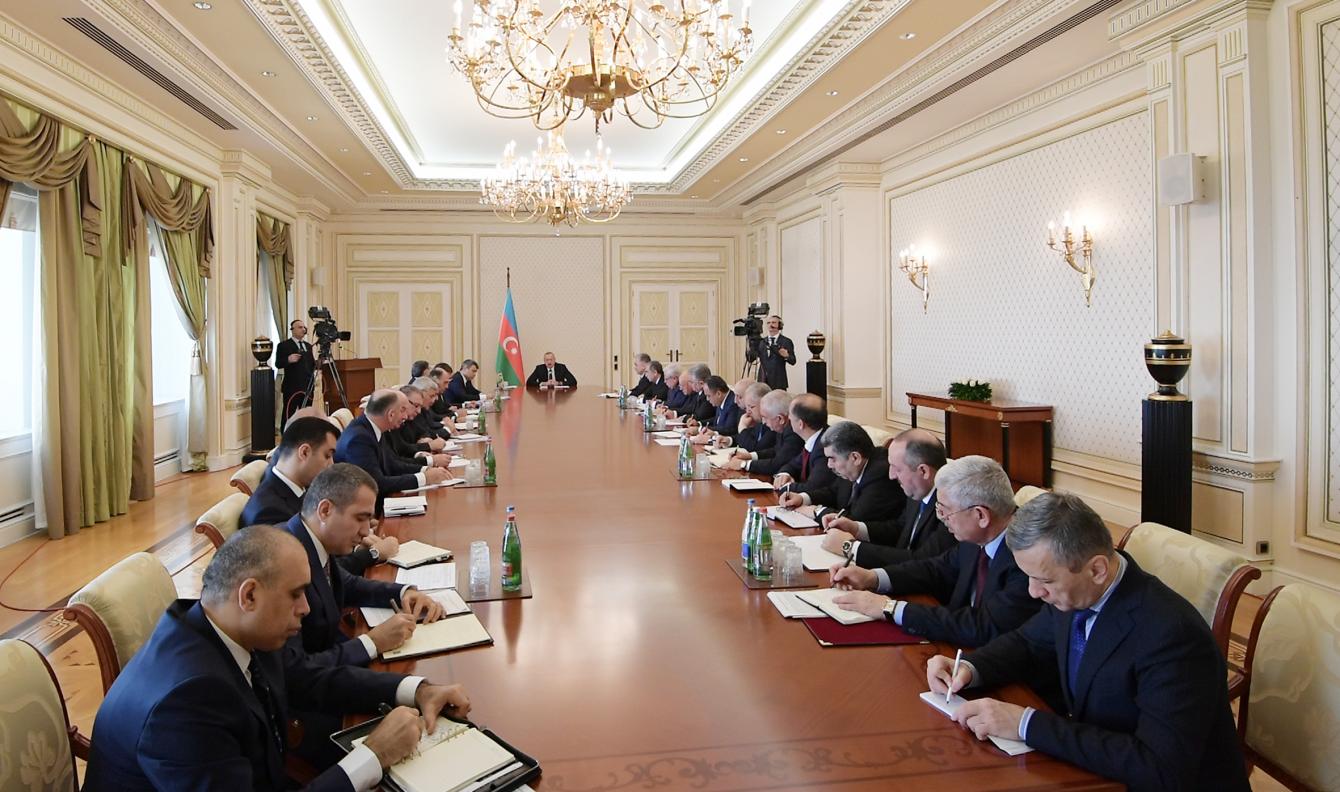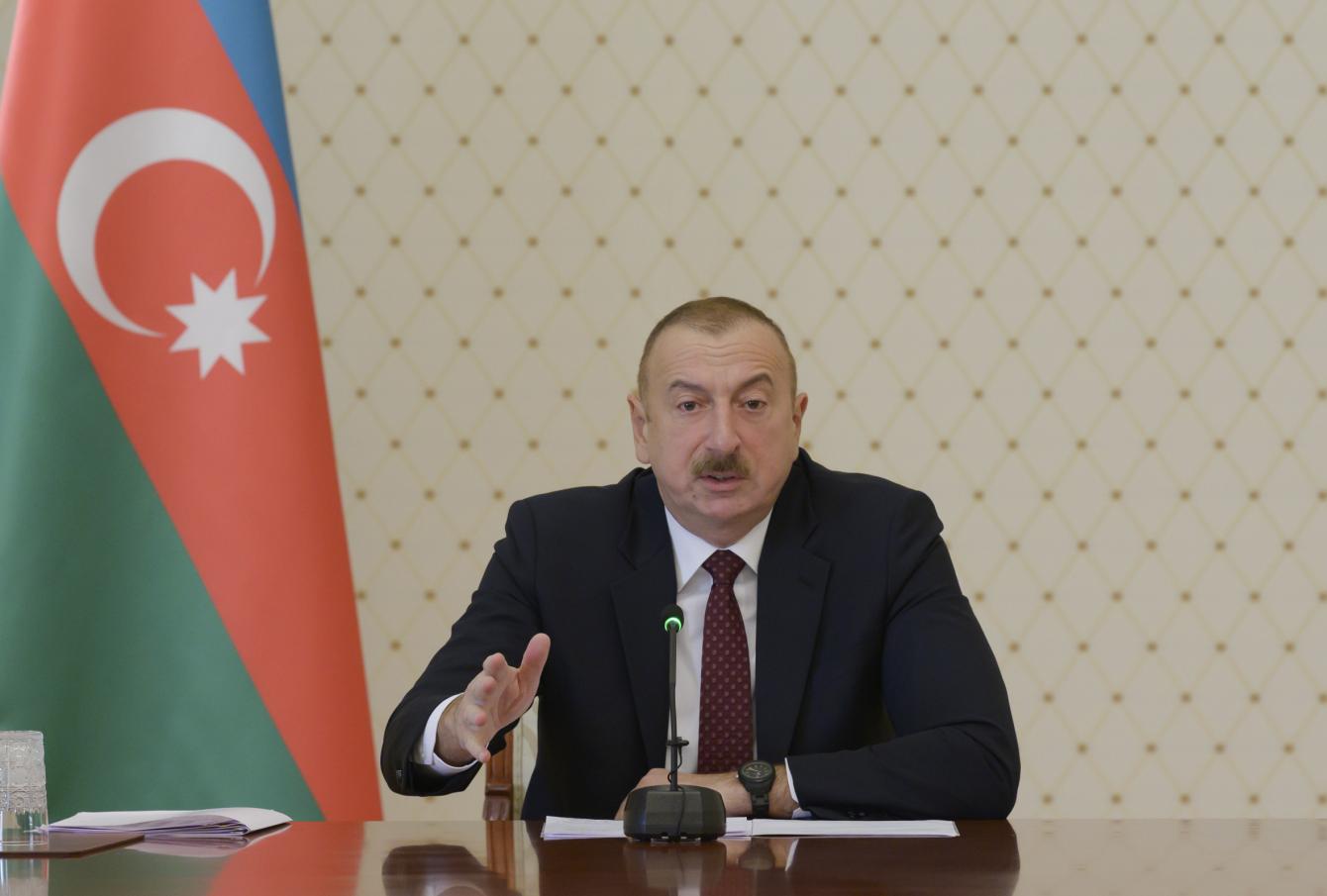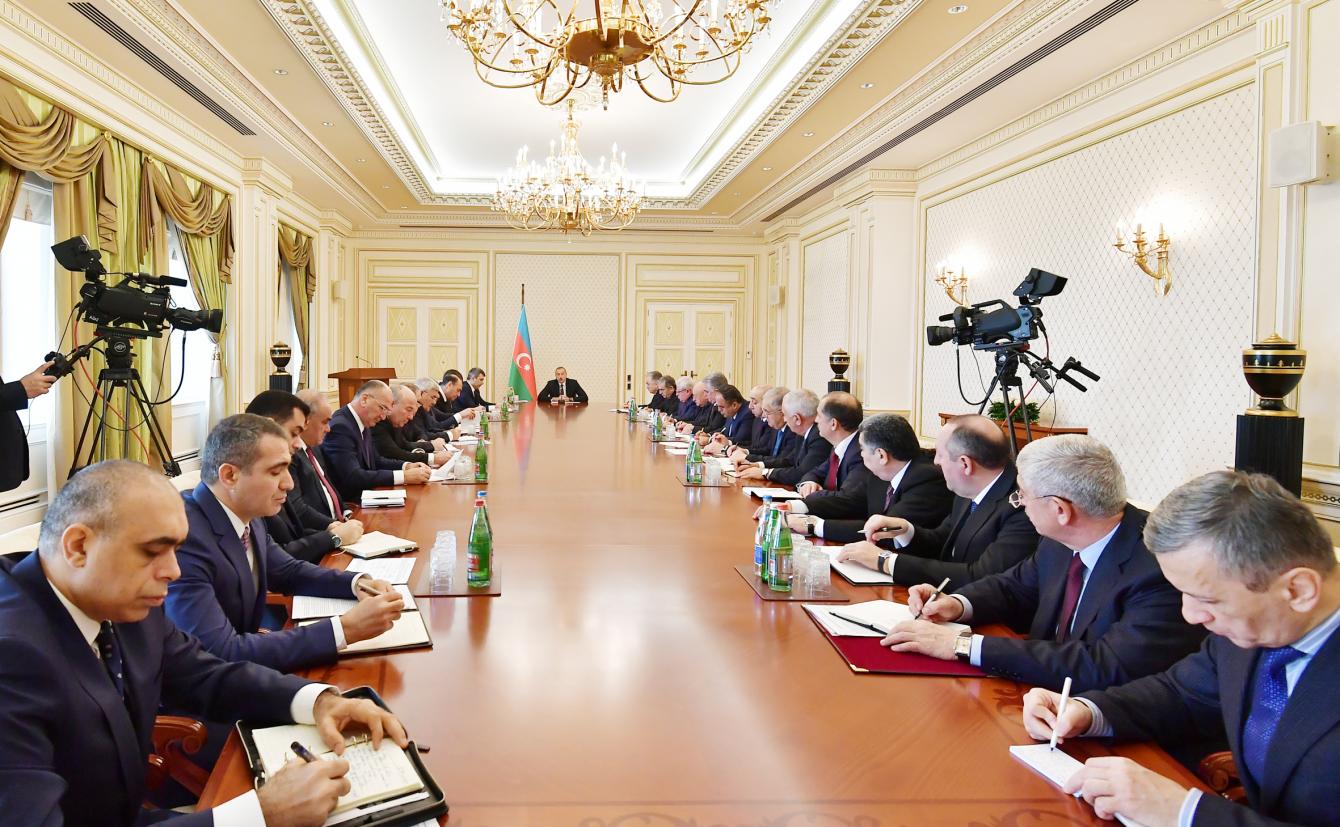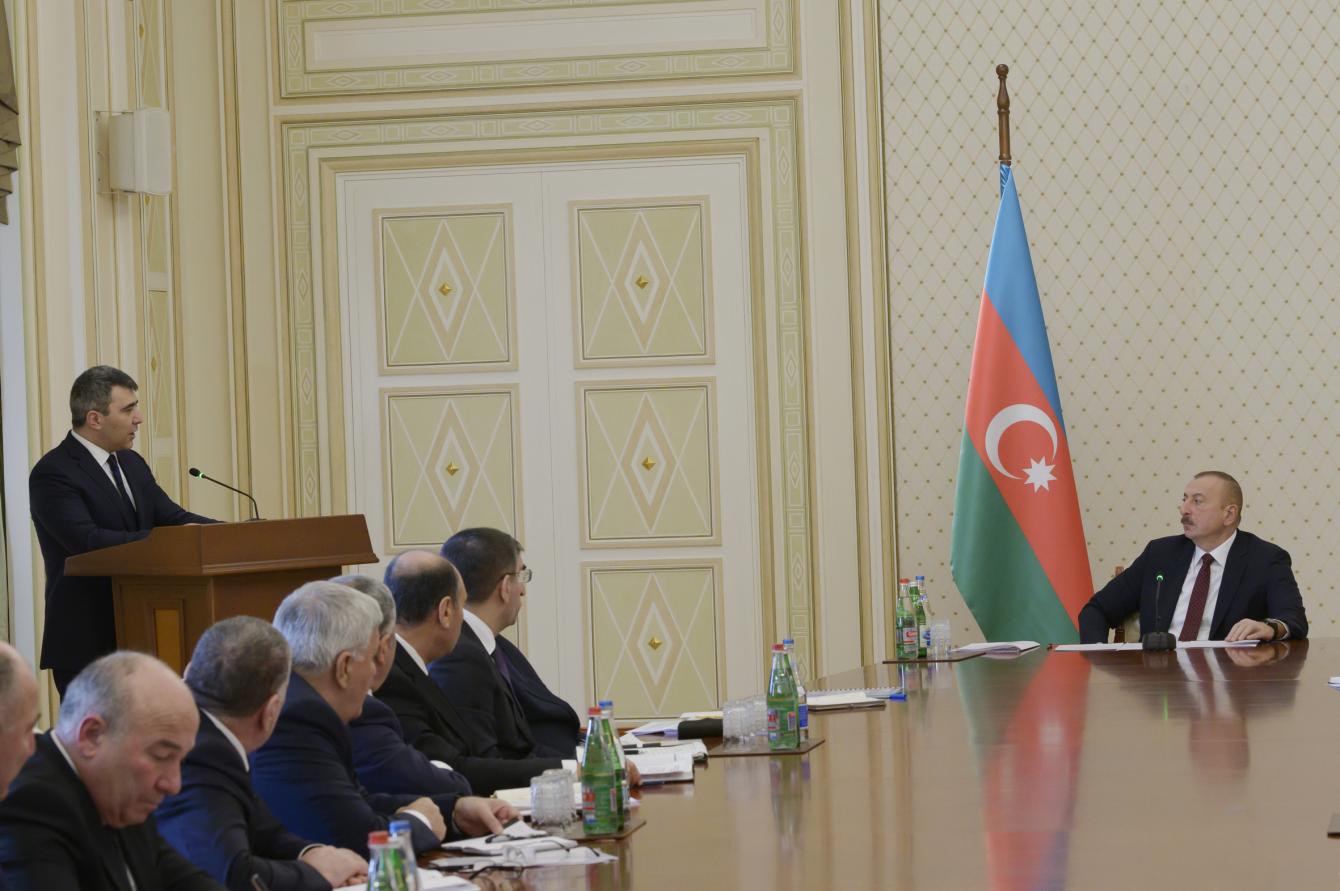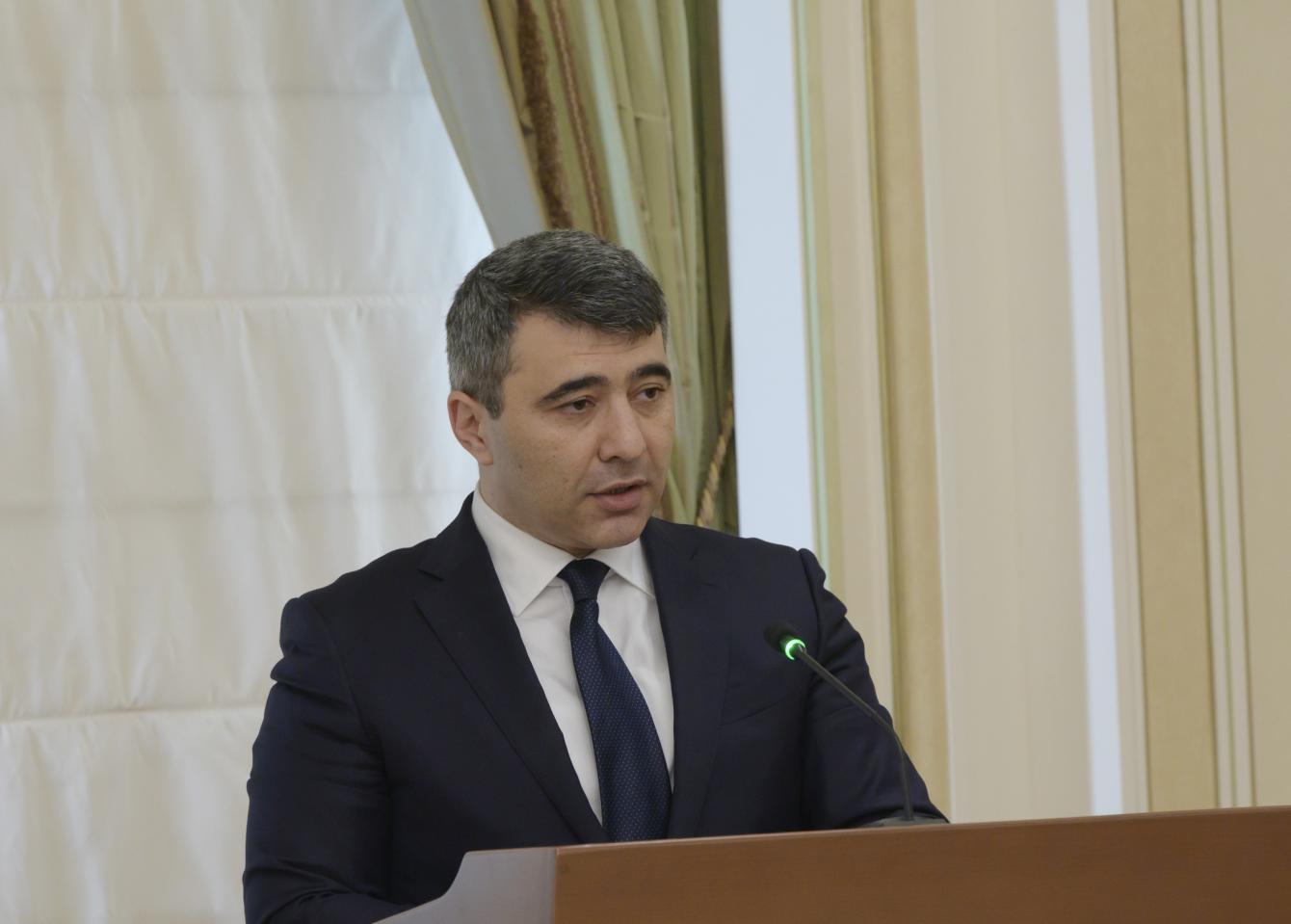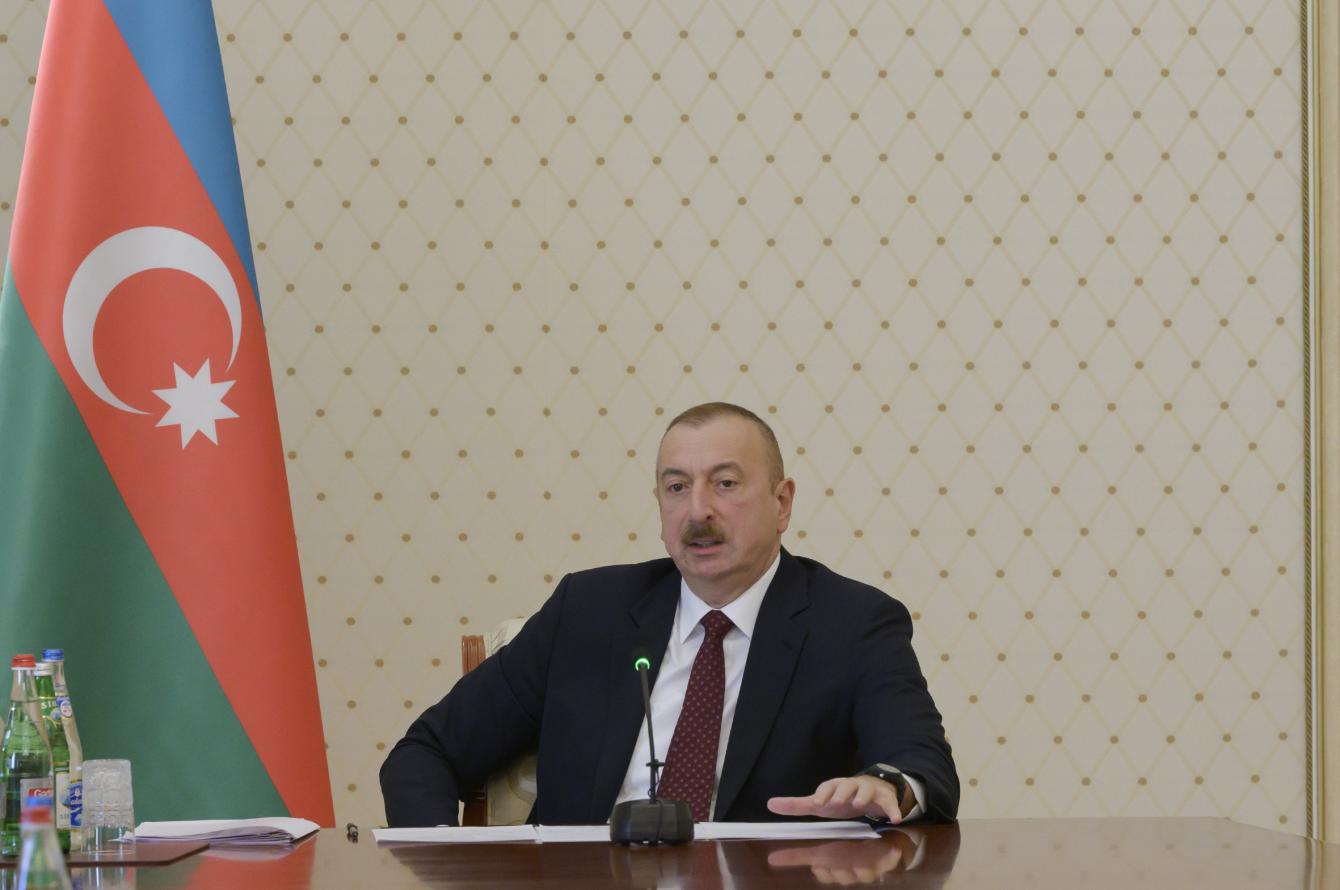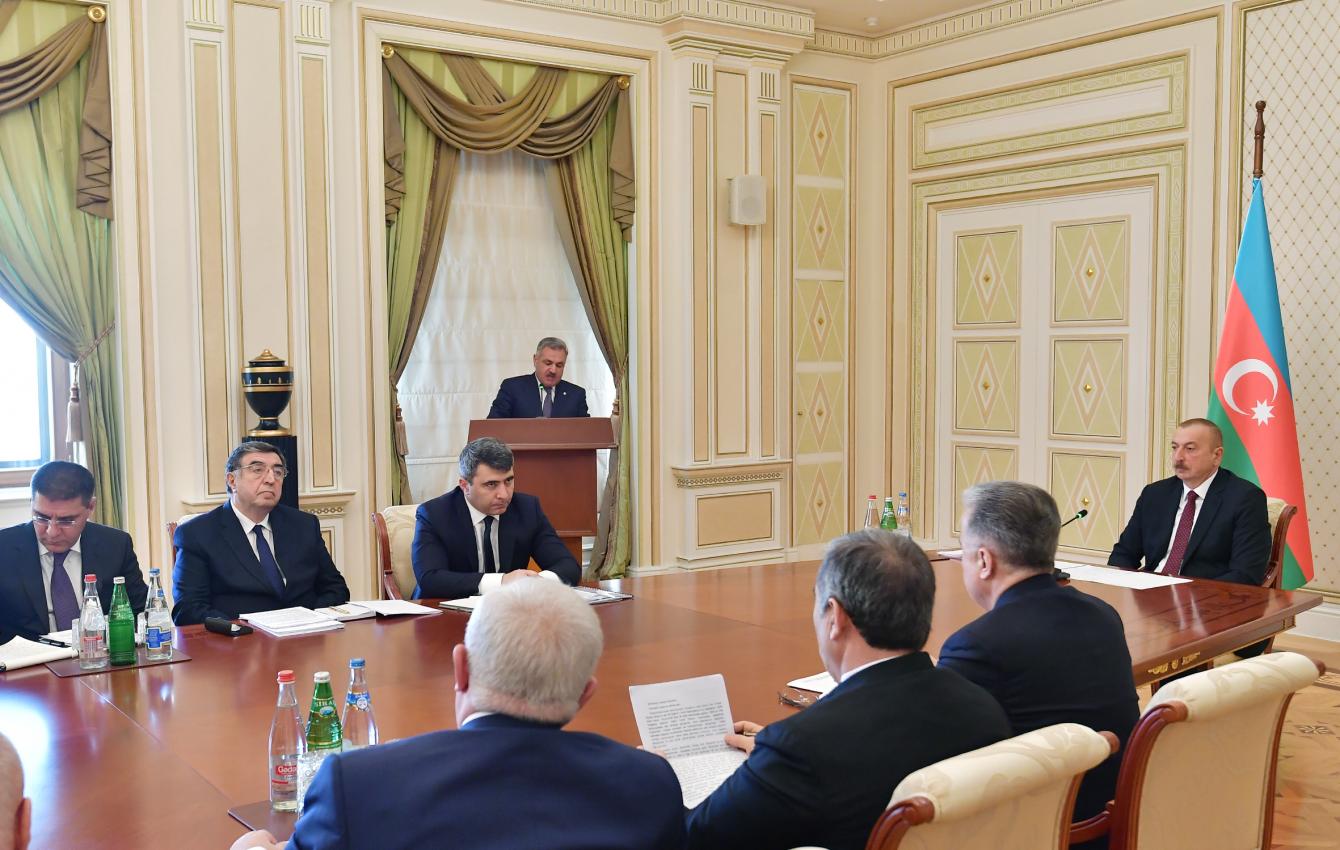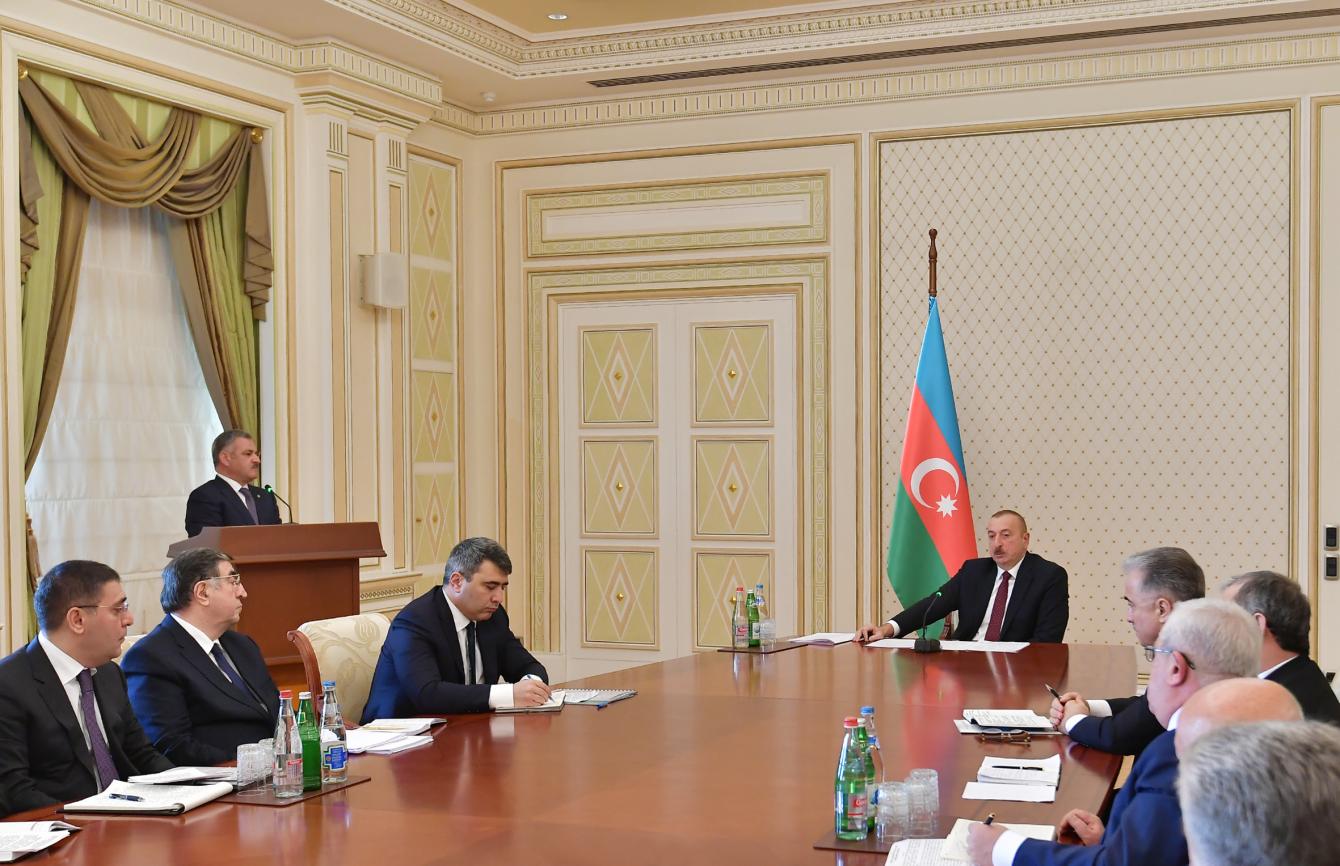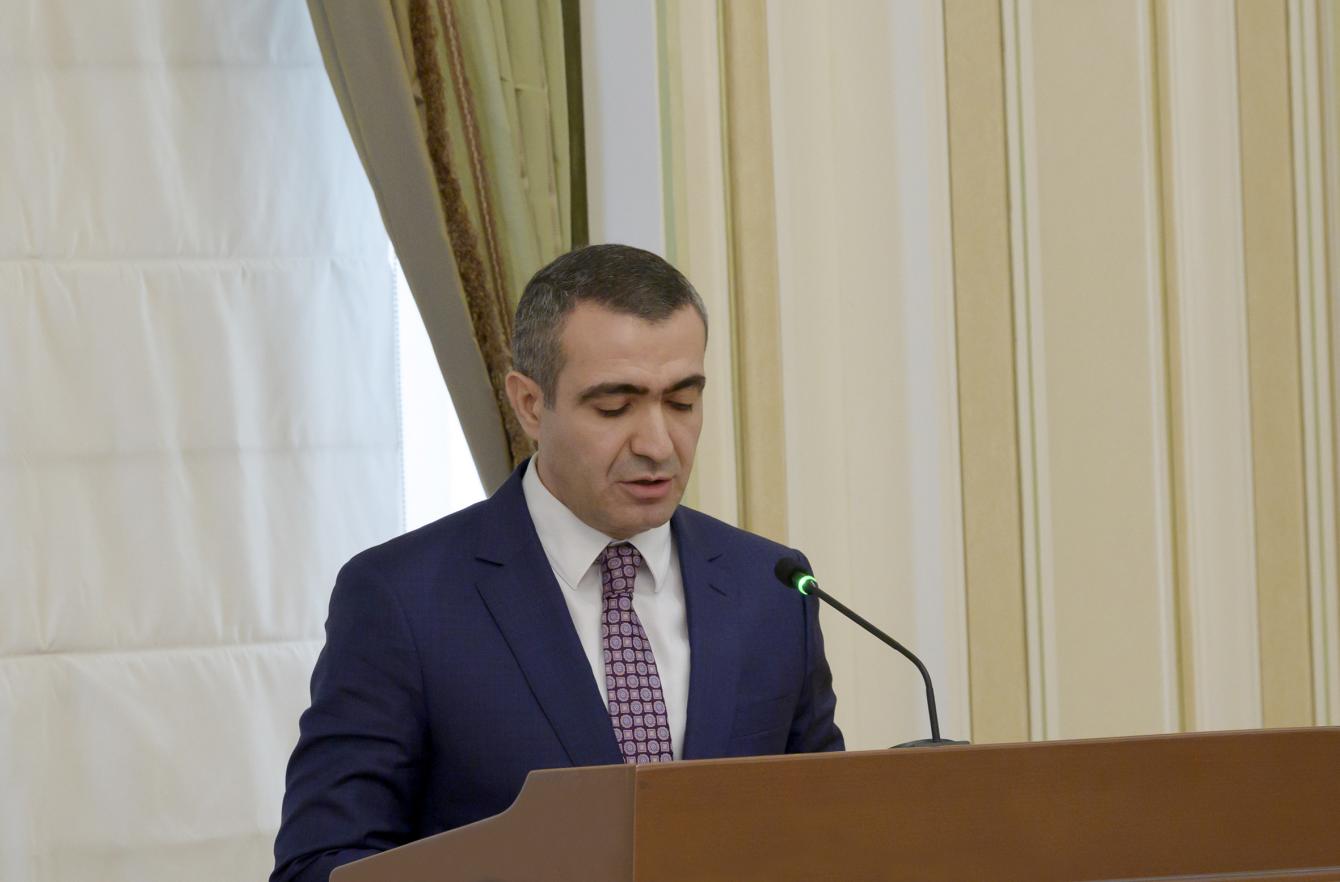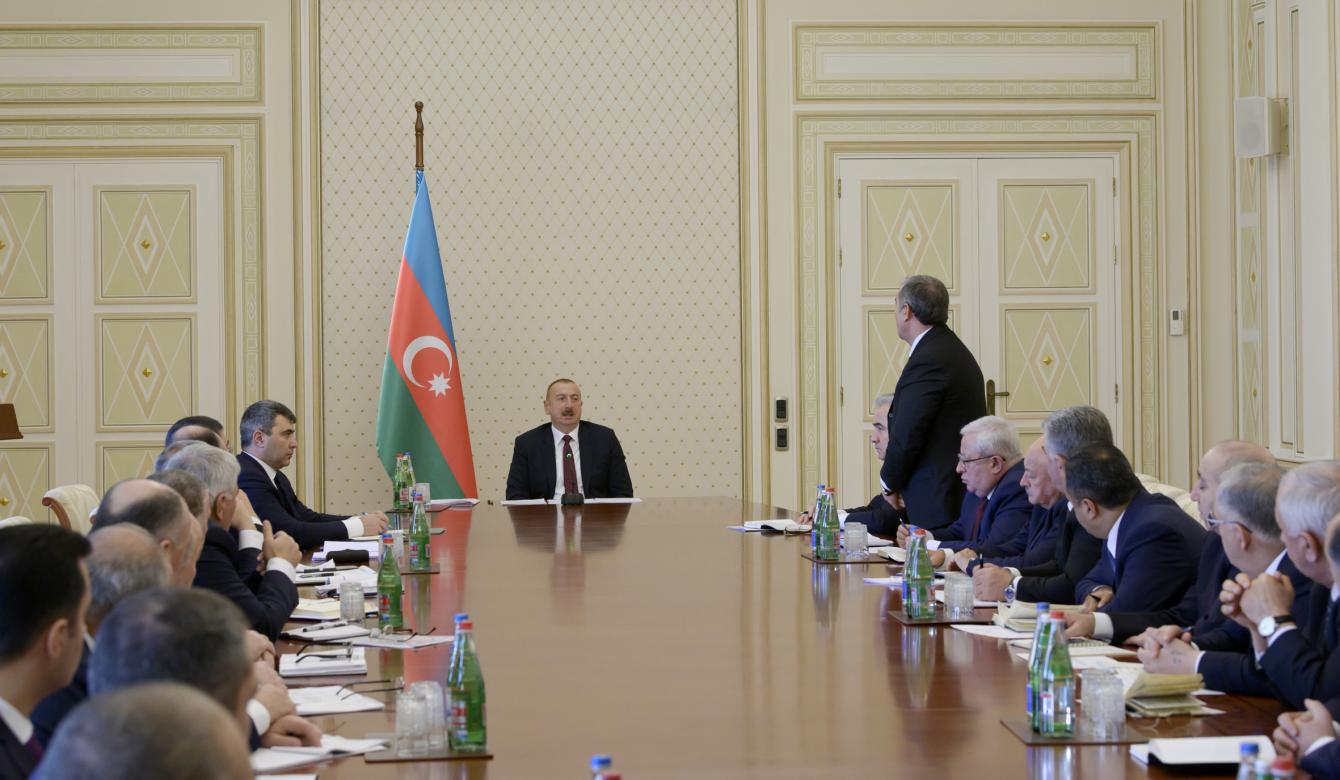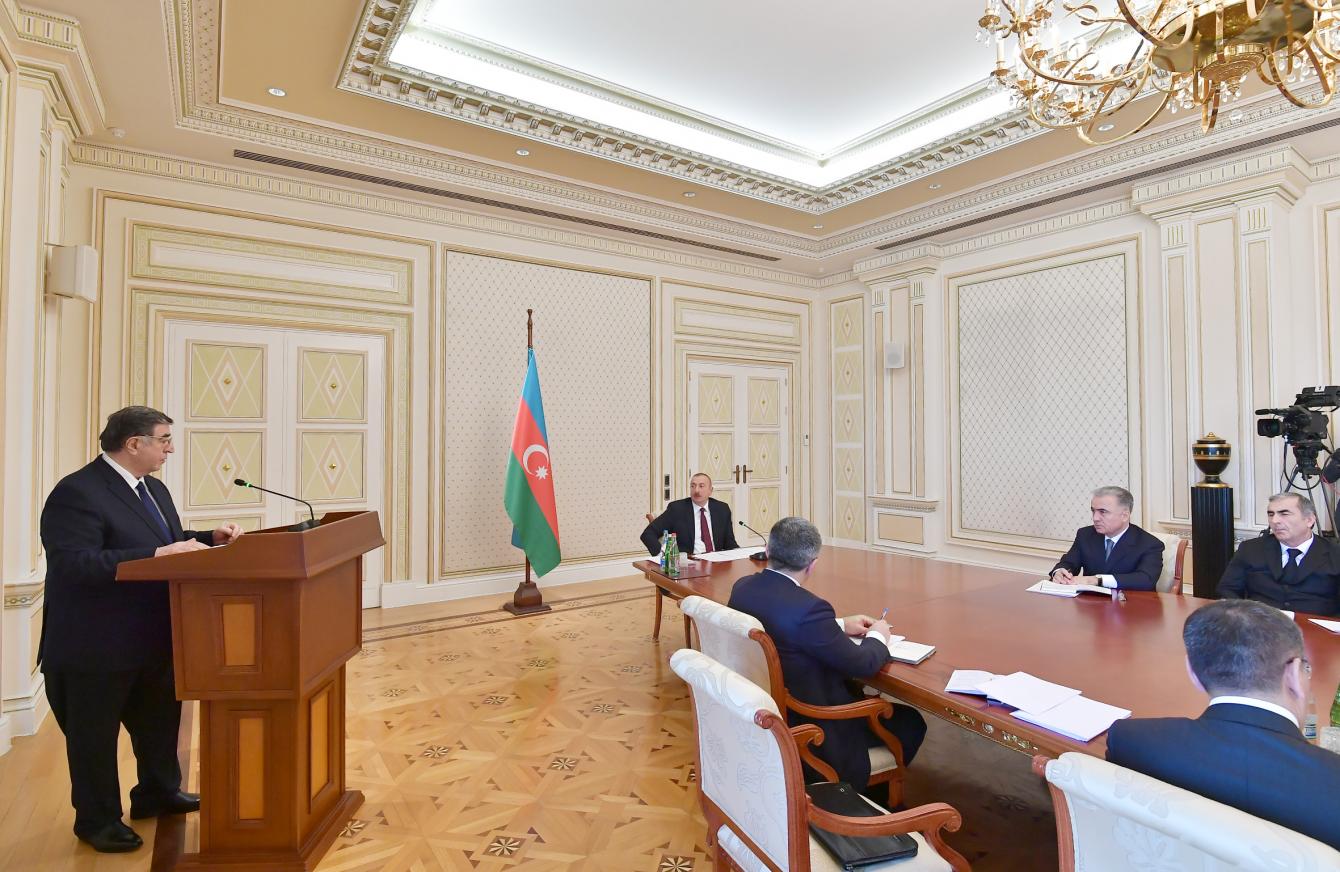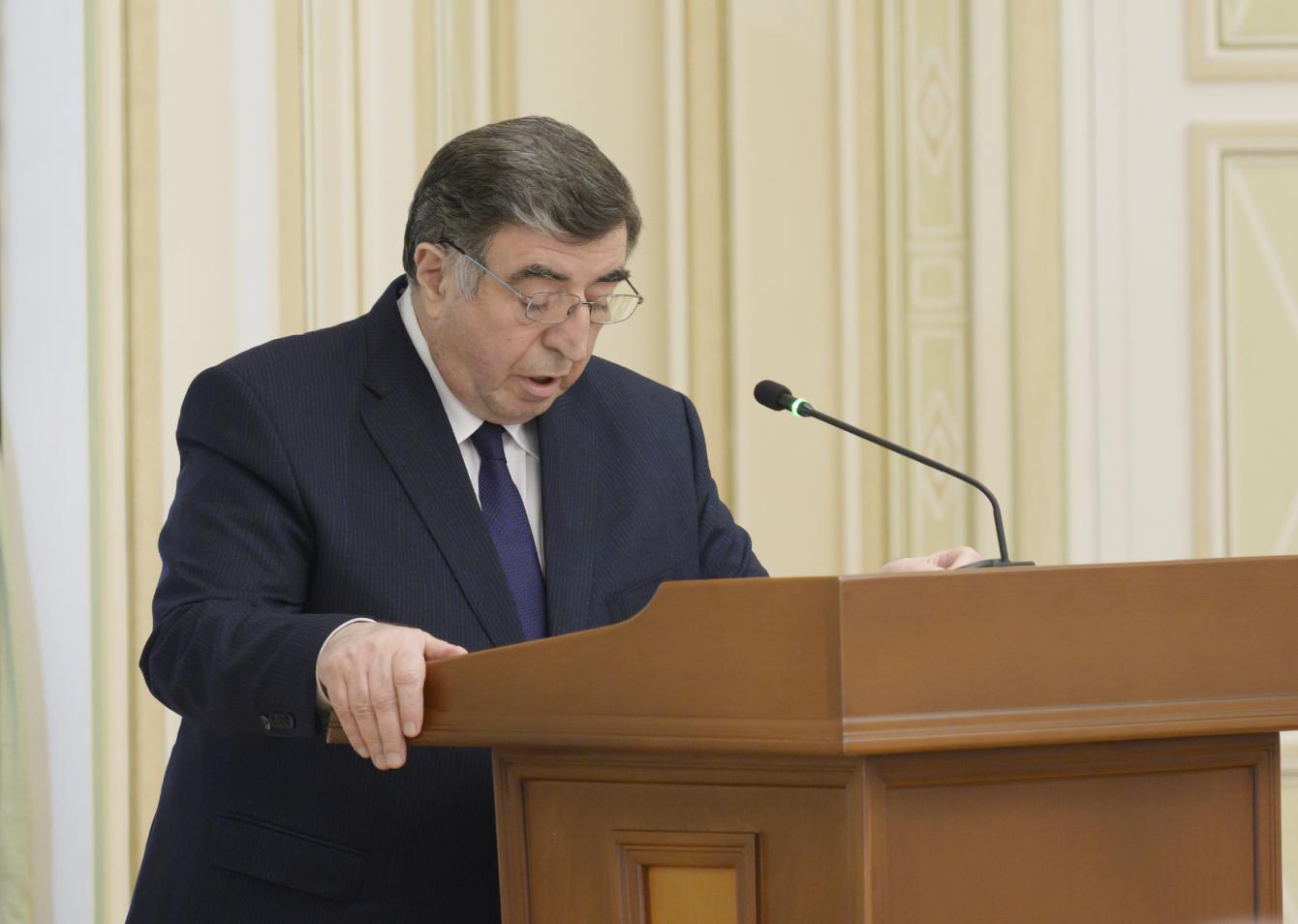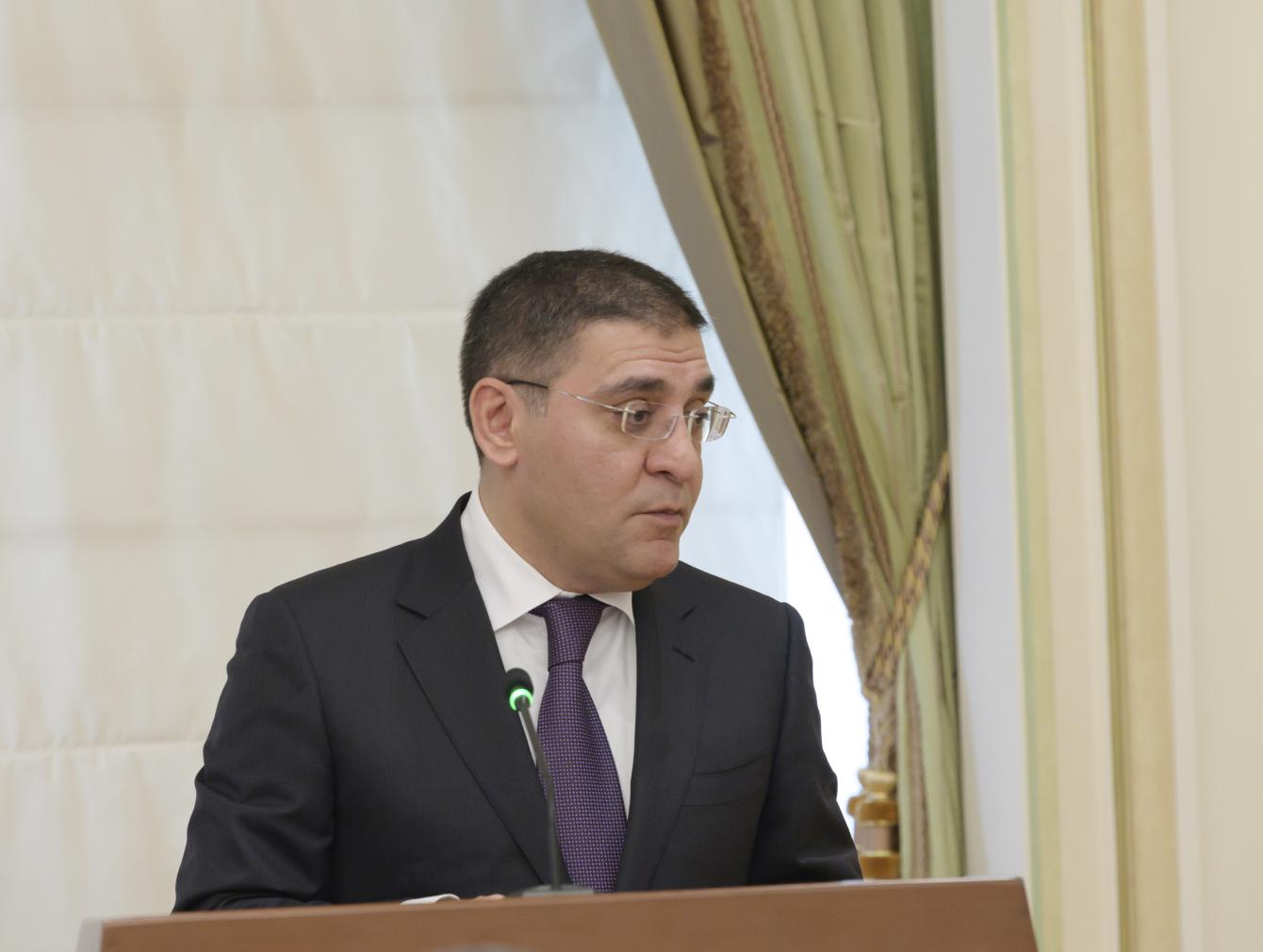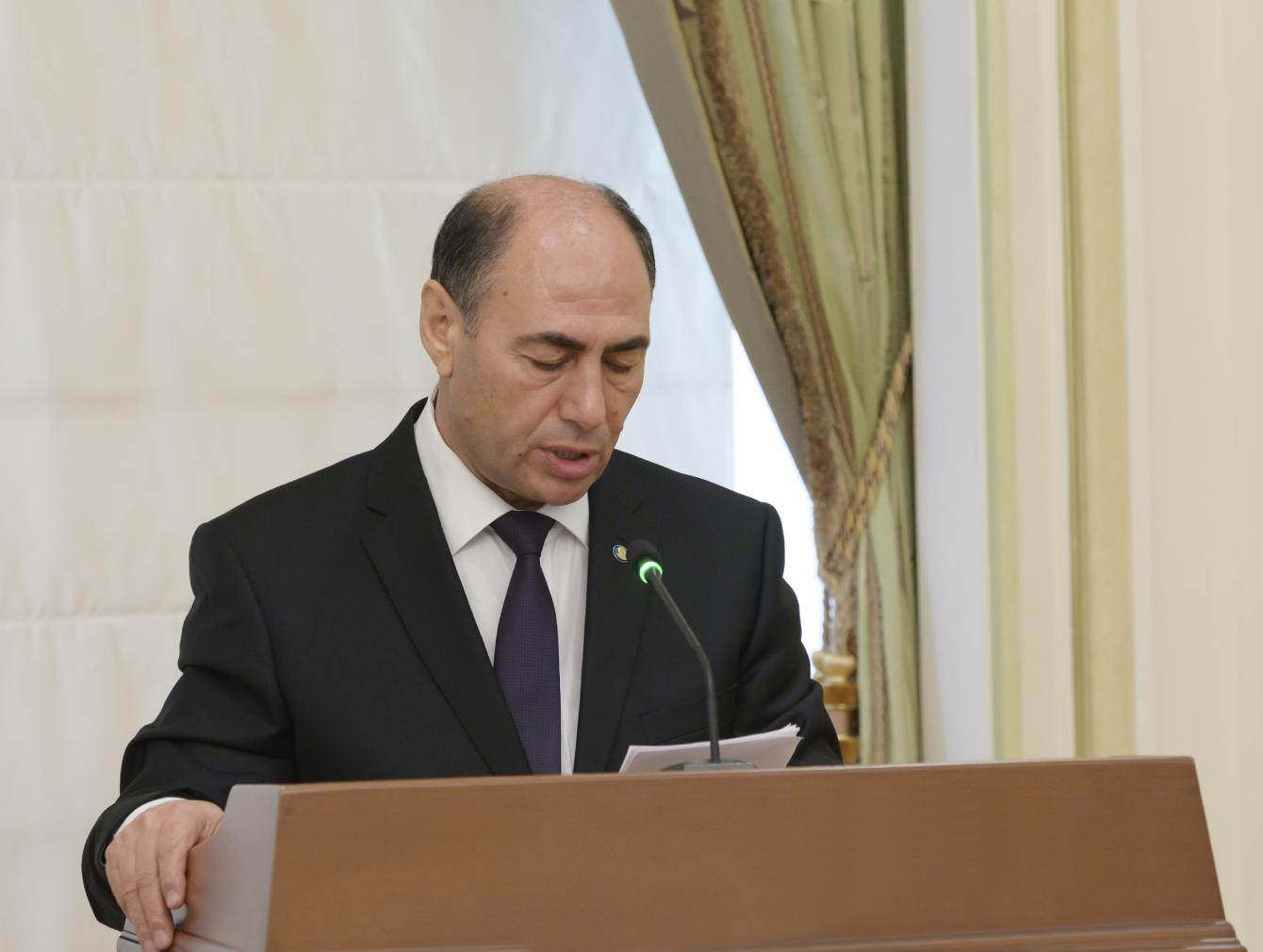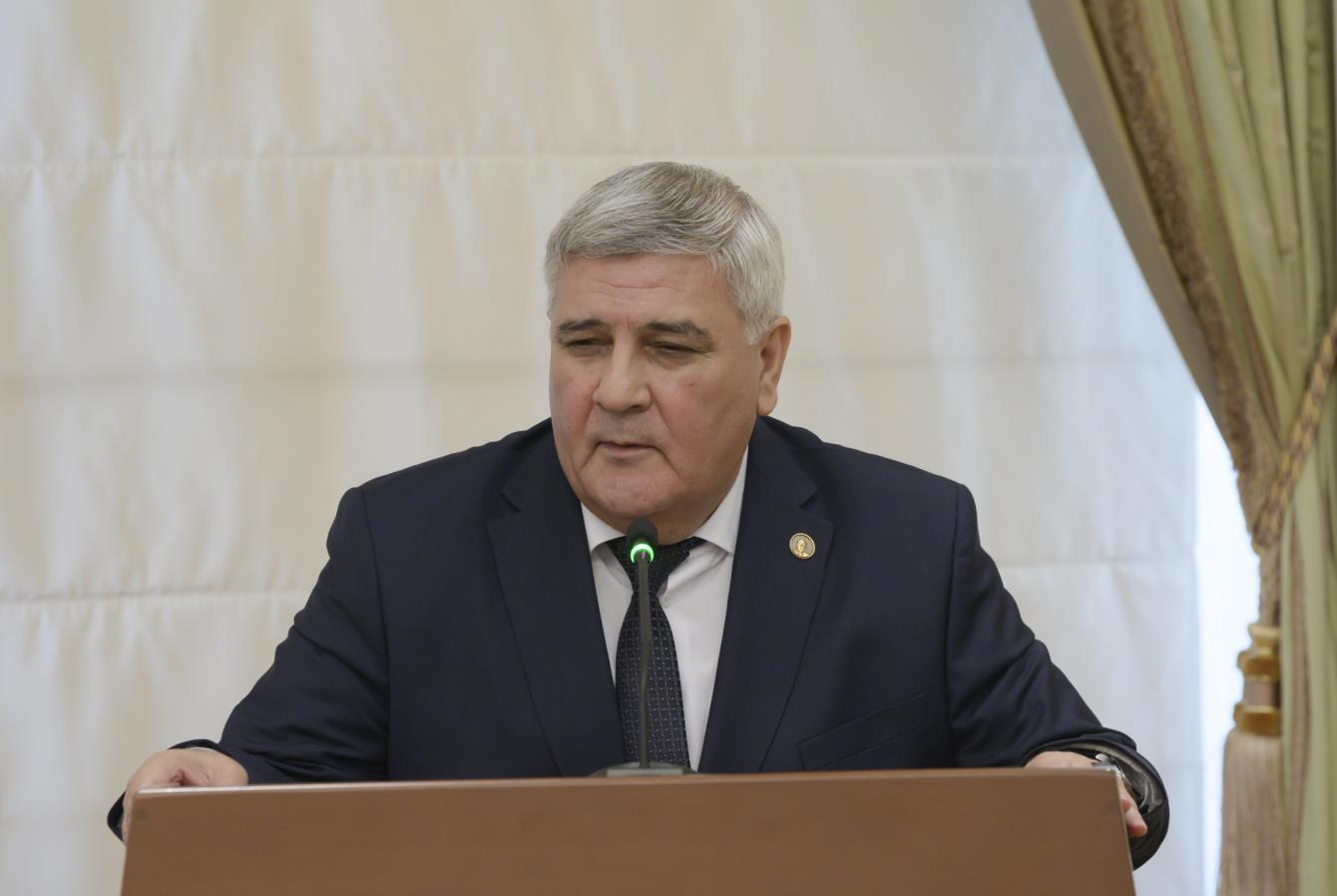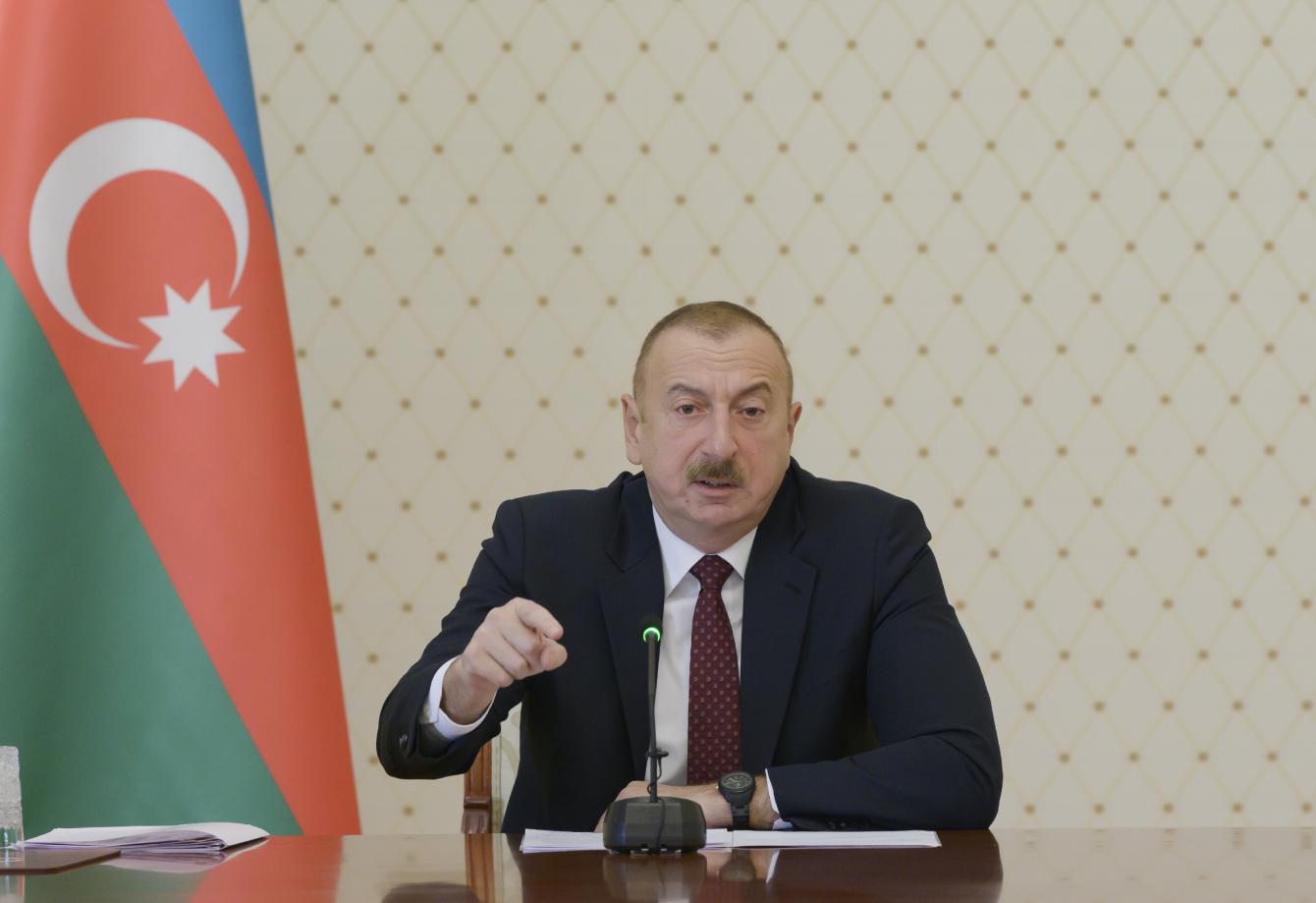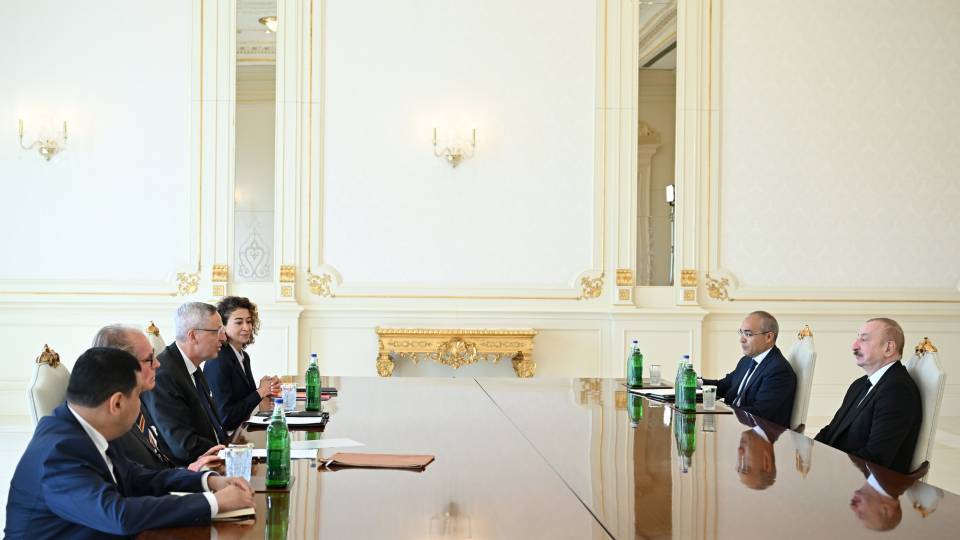President of the Republic of Azerbaijan Ilham Aliyev has chaired a meeting on the results of cotton-growing season and the measures to be taken in 2020.
The head of state made an opening speech at the meeting.
Opening speech of President of the Republic of Azerbaijan Ilham Aliyev
- Today we will summarize the work done in the field of cotton growing. It is possible to say that cotton picking is over. A record figure has been achieved this year – 294,000 tons of cotton have been harvested and the yield per hectare averaged around 29.4 quintals. This is a very high indicator indeed. It shows that the steps taken to develop cotton production in recent years are producing effect. This is further evidence that cotton growing cannot develop without state support. It is possible to say that we have revived cotton growing in Azerbaijan, turned it into a very profitable sector and resolved the problem of unemployment in cotton growing districts. Thus, we have achieved the solution of all the tasks we were facing, completed them.
At the same time, we will hold an exchange of views on the work to be done in the coming years. Suggestions will be made on further development of cotton growing successfully. Cotton growing is a traditional sector of agriculture for us. Peasants have been engaged in cotton growing in Azerbaijan since ancient times. Statistical records of development in cotton growing date back to 1913. In 1913, cotton was sown on an area of 100,000 hectares in Azerbaijan and the yield was only 6 quintals per hectare. In subsequent years, cotton production increased. But the most rapid growth is associated with the name of great leader Heydar Aliyev. Thanks to his activities, not only cotton growing but also all other agricultural sectors successfully developed. If we turn to statistics, we will see that coconut growing, viticulture, cotton growing, fruit growing and vegetable growing reached a peak under his leadership. Thus, those living in villages improved their financial situation, built houses, purchased cars and household appliances. In other words, Heydar Aliyev’s activities during his leadership of Azerbaijan in 1969-1982 turned Azerbaijan from the most backward into the most advanced republics of the Soviet Union. Even more importantly, the well-being of the Azerbaijani population significantly improved.
For information, I can say that in 1969, when Heydar Aliyev was elected first secretary, cotton was sown on an area of 200,000 hectares in Azerbaijan and about 300,000 tons of crops were harvested, i.e. the average yield was 15 quintals. In the early 1980s, productivity approached 30 quintals and was even than 30 quintals for several years. Cotton harvesting was stable at about 800,000 tons. In 1981, this figure increased to 1 million tons.
After Heydar Aliyev left for Moscow, the situation in agriculture, including cotton growing and indeed all other areas, started to deteriorate. It is possible to say that viticulture was completely destroyed. I can say that this happened as a result of the crime committed both by the Soviet government and the then Azerbaijani leaders. Viticulture had great traditions in Azerbaijan. Under Heydar Aliyev, production reached 2 million tons. Azerbaijan was the biggest producer of grapes in the Soviet Union. The republics following us could not produce even a million tons. Our production amounted to 2 million tons. It is not difficult to imagine what benefits this was bringing to both the republic and peasants. Viticulture suffered great damage and vineyards were destroyed. So a treacherous and criminal policy was carried out, as a result of which Azerbaijan’s agriculture was practically destroyed. Unfortunately, this was done by those who were in power in Azerbaijan at the time.
As I said, after Heydar Aliyev left for Moscow in 1982, a recession began in cotton growing and production gradually decreased. In 1991, when Azerbaijan gained independence, cotton production dropped to 500,000 tons and to 280,000 tons in 1993. As you know, the early years of independence were very challenging, the country was in a very difficult situation. As a result of the Armenian occupation, civil war, the negligent and criminal activity of the PFPA-Musavat tandem, our country found itself on the verge of a precipice. The country was dominated by a total crisis – political, military and economic, inflation exceeded 1000 percent, industrial enterprises were paralyzed, agriculture collapsed, there were pervasive robbery, bribery and arbitrariness. The treacherous elements leading the PFPA-Musavat tandem were destroying and dismembering Azerbaijan like enemies. They seemed to be acting on orders of some criminal. As a result of this, of course, industry was paralyzed, agriculture was completely ruined and the country came to an uncontrollable state. Only after Heydar Aliyev returned to power at the request of the people did the situation stabilize. Azerbaijan was put on the path of development, and we see manifestations of this development in all areas today.
At that time, in order to get out of this difficult situation, two key factors had to be provided. One of them was the attraction of foreign investment, and we have achieved this. When we celebrated the 25th anniversary of the “Contract of the Century” this year, I once again shared my thoughts on the significance of this contract and the historic work the great leader did in this field. I said that we had brought investments amounting to billions of dollars to the country. Another way out was through privatization. At that time, very serious economic reforms began to be carried out, land was transferred to peasants and farmers. Of course, this was the right step. But it is also true that the equipment left over from the Soviet era was no longer serviceable, there was no experience that would meet modern standards in terms of agrotechnical measures, and there were serious problems related to fertilizers and pesticides. The lack of fuel was another major. Therefore, private businesses, peasants and farmers experienced great difficulties with the organization of cotton production at the modern level. It would be wrong to blame peasants for that. But the activities of companies that had privatized ginneries and promised to develop cotton production cannot be considered satisfactory, of course. In fact, their work deserves the worst assessment. It is possible to say that as a result of their negligent activity, cotton growing in Azerbaijan came to naught and unemployment in cotton growing regions acquired large proportions. Private businesses did not cope with this task, did not make the necessary investments, could not ensure the effective operation of the ginneries and I can say that they were general indifferent to this issue. Thus, there was a serious decline in cotton growing. In fact, it is possible to say that we lost this profitable labor-intensive sector which was traditional for us. I can cite one figure: in 2015, cotton was sown only on 18,000 hectares and 35,000 tons of crops were harvested. Notice how cotton harvesting dropped from one million tons in 1981 to 35,000 tons.
You know, we live in a market economy, and all its manifestations are evident in Azerbaijan. Suffice it to say that 85 percent of our economy is currently formed in the private sector. All enterprises for except strategic state ones operate in the private sector. The laws of a market economy dictate the need for market liberalization, minimization of government intervention in the economy, and these economic issues should be regulated by market relations.
However, we do not always come across such a picture in reality. Government intervention is particularly necessary in countries that have recently gained independence. Without public policy, we would not be able to achieve these successes. If the state hadn’t supported energy, transport, infrastructure and agriculture, if we hadn’t taken serious steps in the field of industrial development, if we hadn’t pursued our policy, then what successes could we be discussing today?! Can the private sector invest in infrastructure? Of course not. Can someone without state support invest in viticulture, where the farmer must wait for an income for at least seven years? Who would invest in the reconstruction of ginneries without state support? Today we are acquiring the most advanced cotton harvesting machinery – US-manufactured John Deere combine harvesters. We have purchased more than 400 combine harvesters. In total, we have spent more than 500 million manats to buy machinery. What private company can take this up? Therefore, seeing that we are losing cotton growing and that this can lead to major problems, I immediately gave instructions and began to deal with this issue myself. I saw that the principles of a market economy in this sector do not work. A serious plan of measures was drawn up and a state program was adopted covering 2017-2020. Based on the state program, we can say that we revived cotton production and achieved the highest results in four years.
Therefore, thanks to the state support, 15,700 units of machinery have been purchased over the past three years. As I have already noted, we have purchased more than 400 cotton harvesters. The vast majority of them are efficient harvesters of the most advanced American company John Deere. They meet the highest quality standards. This has allowed us the opportunity to collect 87 percent of the cotton using machinery, and the share of manual labor has decreased. In parallel with this, of course, while developing cotton growing as a labor-intensive sector, we first of all kept the problems of unemployment in the spotlight and achieved this.
On to irrigation. Irrigation activities were carried out on an area of 100,000 hectares. We all know well that this year was very dry, none of us remembers such a drought. Despite this, water supply for cotton fields was organized. Of course, if the state hadn’t invested, built canals and allocated funds for land reclamation and water management, cotton would either not be sown today or would have been sown but remained in the fields and burned.
Cotton farmers were granted preferential loans. Repair, restoration and adjustment work was carried out at ginneries. At the same time, a new high-tech ginnery was built in Ujar District. In 2016, the state began to pay producers subsidies in the amount of 10 gapiks per kilogram of cotton. Whereas in 2015 the purchasing price of cotton was 41 gapiks and in the 2016-2017 period 50 kopecks, since 2018 this figure has reached 65 gapiks, which is a very stimulating factor. Pesticides started to be provided on favorable terms. Benefits per hectare were increased from 10 to 50 manats. Fertilizer benefits have been increased from 100 to 150 manats. All these steps are evidence of the attention the state is paying to this sector and the importance it attaches to it. It is no coincidence that the result was achieved very quickly.
Of course, while developing cotton growing, we always kept the social factor in the spotlight, because, as I have already noted, cotton growing is a labor-intensive branch of agriculture. Currently, cotton is grown in 20 districts of Azerbaijan, where about 200,000 people are involved in the work. So cotton growing has several directions, and thousands, tens of thousands of jobs are created in each direction. Just imagine what the creation of about 200,000 jobs in 20 districts means. Now the population of our districts is about 100,000-150,000 people on average, a maximum of 200,000 people. We can say that on average 10,000 people are engaged only in cotton growing in each district. Of course, problems associated with unemployment in these districts are being successfully addressed. At the same time, we have a great indicator. As you know, to enhance social protection, we have now created about 40,000 paid public jobs funded by the state. Those unable to find a job are provided with work in these public places. The need for these jobs is already decreasing in cotton growing districts now because people earn more money in cotton growing, thereby improving their financial situation.
Thus, as a result of the comprehensive measures taken over the course of four years, we have revitalized cotton growing. To confirm my words, I will cite a few figures. Thus, in 2015, the year when I saw that we had lost this sector, 35,000 tons of cotton was harvested from 18,000 hectares. The yield per hectare was 18.8 quintals. In 2016, cotton was sown on 51,000 hectares and 89,000 tons were harvested. So 2016 was the first year when we tackled cotton production seriously. The yield per hectare amounted to a little more than 17 quintals. In 2017, we sharply increased the sown area. I must also say that later we realized that some lands were chosen incorrectly, so we reduced such plots. However, we could not foresee everything, of course. Therefore, in 2017, we sowed cotton on 136,000 hectares and harvested 207,000 tons. But the yield per hectare reduced to 15.2 quintals because some lands were unsuitable for cotton growing. In 2018, sown areas already began to decline, and cotton was sown on 132,000 hectares. Nevertheless, we harvested a lot – 233,000 tons. Productivity per hectare increased to 17.6 quintals. This year, I think, the most optimal combination was recorded: cotton was sown on 100,000 hectares and 294,000 tons of crops were harvested. The yield per hectare was 29.4 quintals. So this is a truly historic achievement.
I also have statistics from the 1980s. I can say that the yield in Azerbaijan exceeded 30 quintals per hectare for only three years. In 1979, it was 30.8 quintals, in 1980, it was 35.4 quintals and in 1981, it was 35.9 quintals. Throughout history, the yield per hectare was close to 30 quintals only three times, and this year we are already seeing this. I am sure that as a result of the measures that will be taken in the future, the yield will increase even more. There will be reports about that now. There are currently pilot projects. In pilot projects, cotton is sown on the basis of modern technologies and the yield is higher. If we distribute pilot projects across the country, then, of course, we will collect even more crops from 100,000 hectares.
Cotton growing is a very profitable sector of agriculture. I also remember that in 2015, when I started to deal with this issue personally, some members of the government believed that cotton growing should be removed from Azerbaijan. They believed that this is unprofitable and has no future. Honestly, I was surprised how this was at all possible, because cotton has been grown here for centuries, our villages have been active in this sector for centuries. This is a traditional sphere, we have a lot of experience and people are used to it. Didn’t people in Soviet times know where it was possible to grow it and where it wasn’t. At that time, everyone knew this. There was a State Planning Committee, which knew exactly where and what to grow and build. Therefore, I want to say this once again, our vision and a focused policy have turned cotton growing into a profitable sphere, and a revenue chain has already been created. In addition, cotton is an exportable product. To sell cotton fiber, we do not need to look for markets – it is sold on stock exchanges. One of the main challenges facing manufacturers in any country is associated with accessing markets. Markets are also limited. Many countries have started providing for their needs using domestic capabilities. Reducing dependence on imports is not only our policy – many countries follow this path. If our traditional markets meet their needs from domestic resources in the future, then where will we sell our cotton fiber? What will we sell? Cotton is a product for which there is no need to look for a market. There are stock exchanges, and it is sold on stock exchanges. Moreover – we will talk more about this – if we create this chain from collection to final production, and we must create it, then at the end of each chain we will have added value. Thus, the workforce involved in this business will grow and incomes will increase.
We are currently at the initial stage of this work. Despite this, I can say that in the first nine months of this year, cotton production has brought farmers, companies and Azerbaijan as a whole an income of $111 million. In other words, products worth $111 million were exported, including $87 million worth of cotton fiber, $22.5 million worth of cotton yarn and $2 million cottonseed oil. At the same time, waste from cotton growing is also used as feed. These figures indicate that we are currently exporting fiber. However, the main task is not only the export of cotton yarn. This is the primary goal. The main thing is to export the final product. To this end, our respective agencies, the government, the Ministry of Agriculture, the Ministry of Economy should work hard to set up enterprises that can give an impetus to cotton growing, attract investors and provide low-interest loans.
As I have already noted, this year's yield was quite high, record high. However, it is impossible to attribute this to all the districts. Therefore, the figures I will provide now should be a signal for the authorities of every district region because representatives of the Presidential Administration, central executive authorities, the heads of executive authorities of 20 districts and representatives of companies are present here today. So this year the yield in seven districts exceeded 30 quintals. These are as follows: Tartar 34.8 quintals, Barda 33.7 quintals, Salyan 33.2 quintals, Neftchala 31.6 quintals, Agjabadi 30.7 quintals, Saatli 30.4 quintals and Beylyagan 30.3 quintals. This suggests that farmers, companies and the leadership of the districts approached this matter very responsibly and achieved such excellent results. In three districts, yields are approaching 30 quintals: Bilasuvar 29.5 quintals, Sabirabad 29.2 quintals and Agdam 28.2 quintals. In seven districts, yields exceed 20 quintals, and they need to draw the right conclusions. And in three other districts, yields are below 20 quintals. A serious analysis should be carried out in these districts – why and for what reason? There must be a reason. Ujar 19.3 quintals, Hajigabul 14.4 quintals and Aghsu 9.9 quintals. The heads of executive authorities of Hajigabul and Aghsu districts have been replaced and new people were appointed. They should thoroughly analyze these issues and explain why the yield is so low.
Let the head of the Executive Authority of Ujar district explain why the yield is currently low.
Head of the Executive Authority of Ujar district Mansur Mammadov: Mr. President, the traditions of cotton growing, as you noted, had been forgotten. Now new varieties of cotton are being grown and sown areas were selected. Pilot projects have been implemented in the districts and yields will increase in the coming years.
President Ilham Aliyev: No, the yield will certainly increase in the coming years. This is not what I am asking. I am asking why the yields were low this year. Please report on that.
Mansur Mammadov: Mr. President, all agricultural measures have been taken. Due to the fact that soil qualities in Ujar created some difficulties, the yield was low. A higher yield was obtained at the pilot sites using the new technology, and this suggests that the yields will be good in the future.
President Ilham Aliyev: Pay attention to this, this is an unbearable figure. Sit down. In fact, yields are high in neighboring districts. For example, in Yevlakh district it is 26.4 quintals and even higher in other neighboring districts.
I have already noted that cotton growing is a very labor-intensive sphere. One of our main tasks is to provide people with work, and we are achieving this. At the same time, I have to note that the measures taken in the social sphere this year and the reforms carried out have significantly improved people’s financial situation. This once again shows that our policy is centered on the people of Azerbaijan. The broad social package arranged and implemented this year covered 4.2 million people. Problem loans have been resolved, and issues related to these loans exist not only in our country. Similar problems exist in many post-Soviet countries. However, we have resolved them in the most favorable and most acceptable form for our people. We have resolved the problems of those who found themselves in a difficult situation after depreciation.
Benefits have been increased – some by 50 percent, others have been doubled. The minimum wage has been doubled, the minimum pension has been raised by more than 70 percent. Today, Azerbaijan ranks first in the CIS in terms of the purchasing power of the minimum pension. This is statistics. Of course, I said this before and want to say again: I want salaries and pensions to increase faster, but to achieve this, our economic opportunities must expand. Economic opportunities depend, among other things, on the effective work in each sector. For example, the agricultural sectors that did not receive sufficient attention before are being revived today. On to industrial production. This year, our non-oil industry grew by 14 percent. Due to transparency this year, tax and customs authorities have transferred 1 billion manats into the budget in excess of the plan. Therefore, all these measures and the reforms have allowed us the opportunity to implement this large package. It cost several billion manats. But we must do it and we are doing it.
Cotton growing is also giving an impetus to light industry. By my orders, industrial zones and estates, including a light industry estate in the city of Mingachevir, are being set up in several cities of Azerbaijan. There is a great need for this because the problem of unemployment in Mingachevir is more serious than in other cities. This is natural because it is a city, and unemployment in a city is usually higher. Therefore, in order to eliminate unemployment in Mingachevir, we must develop it as an industrial city. Two large spinning mills already operate there, I attended their opening. This is the first stage. There should be more factories, we should try to process cotton to the maximum extent because we can’t be satisfied with the current level of processing.
I should also note that a pesticide plant has been created in Azerbaijan. This is also a very important issue. On my initiative, there is also a fertilizer plant and a polymer plant. In other words, we can now already produce finished products from polymers. We can purchase fertilizer but from local producers, not abroad. So all these steps are aimed at making our country stronger, so that it develops rapidly and people are provided with work.
Along with cotton growing, we are developing other branches of agriculture that are traditional for us but which were somewhat forgotten at a certain period. One of them is coconut growing. After starting to deal with this issue, I found out that only 240 kilograms of cocoons were harvested. How much was procured in Soviet times?! Therefore, as a result of the measures taken, we acquired seedlings, a pedigree station was established in Gakh and state support was provided. This year, 630 tons of cocoons have already been harvested. It also allowed the Sheki silk factory the opportunity to operate at full capacity. Hundreds of people were provided with work there. Coconut growing has a great future, it is a very profitable and labor-saving sector. People can make good money in the short term – in a month or a month and a half.
We are rapidly developing hazelnut growing. The area of hazelnut has been dramatically increased – from 30,000 to almost 80,000 hectares. We are already in third place in the world for the production and export of hazelnuts. This is also a very profitable sector. Of course, the recently established gardens do not bear fruit yet. I believe that in a few years, hazelnut growing will become one of the key sectors of agriculture in terms of currency earnings.
Earlier, meetings on rice growing, citrus growing, tobacco growing and tea growing were held under my chairmanship. These traditional sectors are developing. We see cigarettes as exportable products. A new cigarette factory was opened in Sumgayit this year. The Baku factory has been reconstructed. We are both reducing our dependence on imports and creating great export opportunities. So all of these sectors are traditional for us. When the state began to pay less attention to these sectors, they started to fall apart, including viticulture. I just noted that under the great leader 2 million tons of grapes were produced. Dozens of wineries were functioning. All of them became unserviceable and were destroyed. The material of these factories was sold. So a major crime was committed, as this sector industry was practically lost. When I reviewed the numbers, I saw that only 100,000 tons of grapes were produced several years ago, no new orchards were established because it was not profitable. One had to invest, wait for five to six years, collect the crops and decide how to sell it. There were no wineries, no processing, so viticulture was falling apart. In addition, of course, after the great leader left Azerbaijan, the leaders here were active in committing this crime. They were cutting down vineyards. This is a great crime. None of this happened either in Ukraine, Georgia, Moldova, Armenia. Only here. Why? Because Gorbachev sent here an indecent man as a measure of punishment, and his main goal was to destroy Azerbaijan. So he tried to achieve this. But the Azerbaijani people did not allow this to happen, so after committing this crime in 1990, he fled. In the subsequent period, especially when the anti-national PFPA-Musavat group came to power, they did not know or understand at all what agriculture was about. Their goal was robbery. They plundered the Treasury Fund. There was not a single item left in it. They sold everything and stole oil bonuses. If I am not mistaken, oil bonuses worth about $20 or $30 million were provided. They stole them. When a search for them began, there was not a trace of them left. Over one year, they caused damage, looted, stole and pocketed billions of dollars, and then cowardly deserted, abandoning power and freezing their posts. Even today they are causing disgust in our society with their shameful actions. Their cowardice, panic, hysteria, paranoia and betrayal are no secret. This was the real situation.
We have achieved the comprehensive development of our country, as evidenced by all the ratings. Azerbaijan has recently been included in the rating of world’s most powerful countries. There are only 80 countries on this list, and our notorious neighbors are not there. I don’t know where they appear in general, but in any case it is not us saying this, but authoritative organizations of the world. We are in 45th place among powerful states. We are ahead of several developed countries. And I am not even talking about Davos ratings, as I have repeatedly mentioned that. This is today's Azerbaijan.
Of course, we cannot be complacent with the successes achieved. Currently, serious reforms are carried out in the field of agriculture. New mechanisms related to transparency and subsidies are being applied. Previously, both central and local executive bodies committed major violations related to subsidies. This is being stopped now. In this and in all other areas, there must be full transparency, including the creation of paid public jobs. Several heads of executive authority have been dismissed, and one of the reasons was that they squandered the funds intended for the vulnerable. They included their relatives on these lists or these funds did not reach the addressees at all. We have been receiving such signals, they are being investigated and will be investigated even more seriously. Things will not be limited to administrative punishment only – let everyone hear and know this, those who are here and those who are not. Therefore, transparency and service to the state and people should be the main principle everywhere, so that people always feel the attention of the state, just as we are next to our people in any difficult situation.
There was an earthquake this year. Only 10 months have passed, and all major construction work has already been completed. Thousands of houses have been built, repaired and rebuilt. Some say that people should restore these houses themselves and insure them. Of course, they should. And since this issue has been mentioned, I must say that shops must be insured as well, every single one of them, so that in the event of an accident or fire, people could contact an insurance company. But when there is a fire and people have only themselves to blame, they come forward and say that the state should give them money. What country would do that? What government would pay an entrepreneur for an accident? Nothing like this is the case anywhere. Everyone insures their property, and if an accident occurs, the insurance company pays for it, that's all. We should be like that too. I say this to private companies and retail facilities, and warn: if something drowns and burns as a result of a flood or a fire, then one shouldn’t count on state support. In some cases, we do help the poorest, but why should the state provide assistance to entrepreneurs who own expensive cars, estates and villas? This is not fair. The state should help those in need. Well-to-do people should help the poor. I have repeatedly told entrepreneurs about this, they should feel social responsibility. They earn money, the state has created conditions for them. Where else are there such conditions? There are countries in flames. There are wars, conflicts, bloody clashes, mass protests, police violence and destruction in our region, in the Middle East, in Europe, Asia, Latin America,. In our country, there is stability. Who has created it? We have! Who is using it? All our citizens, including entrepreneurs! They live quietly, no-one touches them. On the contrary, the president always supports them. Let them help the poor. We are helping those in need. An earthquake occurred in Shamakhi, Aghsu, Ismayilli. How could we remain indifferent to people freezing in winter? Therefore, we immediately allocated funds, mobilized all agencies and their houses were rebuilt and repaired in 10 months, before the onset of winter. This is our responsibility. Those in need will not be able to restore these houses themselves. It is now necessary to carry out awareness work to insure these houses. So why should the state help a businessman, a wealthy person who owns large estates? This is absolutely impossible, and let everyone draw the right conclusion.
Thus, when discussing issues related to cotton growing today, I want to say again that I appreciate the work done. All the agencies have worked hard. The Presidential Administration coordinated this work. The Ministry of Agriculture, many local executive authorities have achieved good results, and the districts with low results need to draw the right conclusions.
Speakers at the event included Minister of Agriculture Inam Karimov, head of Tartar District Executive Authority Mustagim Mammadov, Director General of “MKT Istehsalat Kommersiya” LLC Rovshan Hasanov, chairman of the Irrigation and Water Management Open Joint-Stock Company Ahmad Ahmadzade, Director General of Azerbaijan Industrial Corporation Kamran Nabizade, head of Barda District Executive Authority Vidadi Isayev and head of Saatli District Executive Authority Nazim Ismayilov.
President Ilham Aliyev made a closing speech at the meeting.
Closing speech of President of the Republic of Azerbaijan Ilham Aliyev
- So I want to say again that I am very pleased with the results of this year. Most importantly, we are seeing that the goals correctly established in cotton growing are being met. Cotton growing has again become a profitable and labor-intensive sector that has a positive impact on the country's economy, including the stability of the macroeconomic situation, the strengthening and stability of the manat.
It is no secret that the main sector, which brings us currency, is the oil and gas sector. Of course, the development of this sector is always in the spotlight. Great success has been achieved. However, our main goal is to diversify the economy through the non-oil industry and agriculture. There has been a significant increase in both the non-oil industry and agriculture this year. The non-oil industry grew by more than 14 and agriculture by more than 7 percent. I am sure that these trends will be continued, and we will thus develop agriculture in accordance with the most modern standards.
I want to say again that we must provide more space to progressive technologies in matters related to cotton growing. Pilot projects were implemented and the yield is very high – about 60 quintals. Therefore, I believe that we should increase the coverage of pilot projects next year, and the Ministry of Agriculture should submit proposals on this issue.
At the same time, we did not pay sufficient attention to one important issue today. It is the issue of seed production. We must put into operation a factory for the production of fiber-free cotton seeds. There is such a project now, and I believe that work should be started next year. In any case, the construction of the factory will last a year, perhaps a year and a half. We must provide ourselves with these quality seeds.
This year, procurement companies quickly paid farmers their due. I am sure that this will be the case next year too. Everyone receives wages on a daily basis and some several times a week. Calculations must be carried out accurately and without delay.
More low-interest loans should be allocated to the cotton growing sector. The Ministry of Economy is being instructed to analyze these issues. Next year, low-interest loans amounting to about 200 million manats are envisaged. Sufficient funds should be allocated to cotton growing.
We need to once again review the activities of our cotton processing plants, because many of them were built in Soviet times. Their efficiency is low and the quality is not up to standard. Therefore, the production capacity of the plants must be calculated accurately because the capacities declared today do not reflect reality. The capacity of the ginneries should be consistent with the increasing volume of cotton, as I am sure we will increase productivity. I don’t want to cite figures now, but in any case, it is expected that more than 30 quintals of cotton will be harvested per hectare next year. In this case, more than 300,000 tons of cotton will be picked. But can our ginneries cope with this volume? This is first. Secondly, the factories need to be modernized. If necessary, the state can provide financial support. A new ginnery was commissioned in Ujar this year. According to the information available to me, it meets high standards, and it was built by the private sector. This is a very positive fact. I believe that businesses should pay attention to this area. In general, they need to determine whether we need new ginneries at all. If we do, to what extent, so that we could calculate the support to be provided by the state in advance. New spinning mills should be created because so far only 40 percent of the harvested cotton is being processed. This is a good indicator. However, we should try to process 100 percent of cotton fiber, as this would create a value chain and jobs. Industrial production will also increase. Therefore, I am addressing the private sector again and urging him to pay attention to this issue. We have enough cotton. Therefore, the construction of spinning mills will turn into a profitable business. If necessary, the state can support these projects with low-interest loans. However, the construction of spinning mills is not the ultimate goal either. The ultimate goal is to produce finished products. With this in mind, it is necessary to build new textile and knitting factories, create factories for the production of feed and oils. All this will strengthen our economy and create thousands of more jobs.
We must meet domestic needs with domestic resources. We currently harvest cotton, and a significant portion of it, 60 percent, is exported as cotton fiber and 40 percent in the form of yarn. The products made from this yarn are subsequently imported by us, and it takes millions, tens of millions. Therefore, domestic production in this area should develop. A chain-type procurement and production complex should be created. The main role here will be played by the partnership between the state and the private sector.
To ensure coordinated implementation of this work as a whole, the Presidential Administration, the Cabinet of Ministers, the Ministry of Economy, the Ministry of Agriculture, local executive bodies and procurement companies, as well as other companies that are not present here today, should draw up a joint action plan. It is necessary to draw up and implement a very broad and detailed roadmap for 2020. Under such circumstances, cotton growing in Azerbaijan will develop at a faster pace and benefit both people working in this sector and the state. Thank you!

